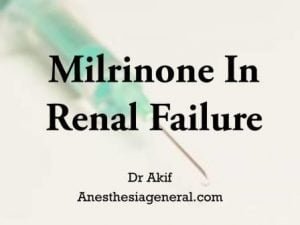Mechanism of Action of Milrinone
Milrinone is a selective inhibitor of type III cyclic adenosine monophosphate (cAMP) phosphodiesterase isoenzyme in cardiac and vascular smooth muscle.
Its inhibitory action on phosphodiesterase results in increased cAMP levels, which in turn increases contractility in cardiac muscle and stimulates vasodilatation in blood vessels.
This causes an increase in cardiac output and decrease in pulmonary wedge pressure. These hemodynamic changes are obtained without excessive changes in heart rate or increase in myocardial oxygen consumption.
Milrinone Indications
The use of milrinone has been best studied in patients with congestive heart failure. It appears to be very efficacious in nonhypotensive patients with acute nonischemic cardiomyopathy, despite treatment with diuretics.
 These patients benefit from an enhancement in contractility and after load reduction. Duration of therapy should last for 48 to 72 hours.
These patients benefit from an enhancement in contractility and after load reduction. Duration of therapy should last for 48 to 72 hours.
There are no studies to date that support its use for a longer period. Long-term oral therapy with milrinone has been associated with increased mortality.
Milrinone Dose
The recommended dose in patients with normal renal function is 50 µg/kg bolus followed by a continuous infusion at 0.375 to 0.75 µg/kg/min. Since milrinone is excreted mainly through the kidneys, its dose in patients with renal impairment should be adjusted accordingly (by surface area):
- Creatinine clearance (CrCl) 50 mL/min/1.73 m2: Administer 0.43 µg/kg/min.
- CrCl 40 mL/min/1.73 m2: Administer 0.38 µg/kg/min.
- CrCl 30 mL/min/1.73 m2: Administer 0.33 µg/kg/min.
- CrCl 20 mL/min/1.73 m2: Administer 0.28 µg/kg/min.
- CrCl 10 mL/min/1.73 m2: Administer 0.23 µg/kg/min.
- CrCl 5 mL/min/1.73 m2: Administer 0.2 µg/kg/min.
An immediate improvement in hemodynamic function is seen within 5 to 15 minutes after initiation of therapy. The mean half-life of milrinone is approximately 2.4 hours and patients reach a steady-state plasma milrinone concentration (of 200 ng/mL) within 6 to 12 hours of a continuous maintenance infusion of 0.50 mcg/kg/min.
The impact of the half-life of milrinone is clinically important as providers must recognize that the effects of the drug cannot be turned off rapidly like many of the other commonly used inotropic agents such as epinephrine.
Caution
It decreases atrioventricular nodal conduction time, allowing a potential for increased ventricular response rates (up to 3.8%) for patients with supraventricular arrhythmias.
Ventricular arrhythmias (ventricular ectopy, sustained and non sustained ventricular tachycardia) have also been reported in up to 12% of patients.
Life-threatening ventricular arrhythmia appears related to the presence of other underlying factors such as a pre-existing arrhythmia and metabolic abnormalities.
Extreme caution must be used in patients with renal compromise. Fatal ventricular arrhythmias developed in six of nine patients in a recent study of the pharmacokinetics of it in patients on continuous venovenous hemofiltration (CVVH).
These patients were oliguric (<400 mL/d) and had a serum creatinine of more than 2.0mg/dL. All patients received 0.25 µg/kg/min of milrinone and developed a mean steady-state concentration of 845 ng/mL, four times higher than that of patients with normal renal function.
The high protein-binding affinity of milrinone and decreased urinary excretion could have contributed to this high concentration, thereby leading to the increased incidence of ventricular arrhythmias.
For more answers to more questions like this Ask a Doctor.
